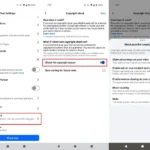In the latest twist in the ongoing battle between TikTok and U.S. lawmakers, reports indicate that TikTok is building a U.S.-only version of the app, aimed at complying with new federal regulations designed to curb foreign influence on American tech platforms.
A recent report by The Information revealed that the app’s parent company, ByteDance, is working on a separated U.S. version internally codenamed “M2.” This development is part of TikTok’s urgent efforts to align with the Protecting Americans from Foreign Adversary Controlled Applications Act before the law goes into full effect in September 2025.
TikTok U.S.-Only Version Could Launch in September
As per the report, the U.S.-only TikTok variant is set for release in early September, with American users expected to migrate to this new version by March 2026. This strategic separation aims to satisfy U.S. legal requirements while allowing ByteDance to retain ownership and operational control over TikTok in other regions.
Currently, it’s unclear how the U.S. version will differ functionally. However, experts believe it will be structurally distinct, especially in how it handles data and algorithms—two of the most hotly debated concerns among U.S. officials and regulators.
Why Is the U.S.-Only Version of TikTok Necessary?
The Protecting Americans from Foreign Adversary Controlled Applications Act mandates that foreign-owned apps either sell their U.S. operations or restructure them to prevent influence from adversarial governments. TikTok’s current structure raises concerns about:
- Data privacy and user information security
- Algorithm transparency and manipulation risks
- Foreign ownership, particularly Chinese control via ByteDance
The most contentious issue has been TikTok’s powerful recommendation algorithm. The Chinese government has refused to allow the sale or transfer of TikTok’s core algorithm, seeing it as a sensitive national technology. This has made a full acquisition by any U.S. company nearly impossible.
Could the Algorithm Be Left Behind?
Creating a U.S.-only version of TikTok may serve as a workaround, enabling ByteDance to comply with American law without giving up its intellectual property. This way, the app can remain available to American users while still separating data flow and algorithm access.
However, this move has potential downsides. TikTok’s global success hinges on its addictive, AI-powered “For You” feed. If the U.S. version lacks this same functionality, it could drastically impact:
- User engagement and time spent in-app
- Creator visibility and content reach
- Advertiser performance and targeting precision
Whether the company can replicate the algorithm or develop a compliant alternative remains unknown.
Trump’s Involvement and Potential Buyers
Just days before the news of TikTok’s internal project surfaced, former President Donald Trump announced that he had identified a buyer group for TikTok’s U.S. operations. He described them as a team of “very wealthy people” prepared to move forward with an acquisition.
Trump has delayed TikTok’s forced divestiture three times during his presidency. But now, he appears committed to resolving the matter before the law’s enforcement deadline. His recent statements suggest that a final deal may be on the horizon—possibly aligned with the September launch of the M2 app.
The timeline seems deliberate. With Trump’s executive extension set to expire in September and the new TikTok variant planned for release around the same period, both efforts may converge to prevent a complete shutdown of the app in the U.S.
What This Means for U.S. Users and Creators
If TikTok rolls out a fully separate version for U.S. users, the transition could significantly impact creators, brands, and everyday users. Some potential changes include:
- Users will need to download the new app to maintain access.
- Creators may need to adapt strategies to new algorithm behavior.
- Advertisers could lose access to existing audience insights or campaign tools.
ByteDance is reportedly designing the migration to be seamless, but historical precedent shows that even small shifts in platform dynamics can disrupt digital ecosystems.
For influencers, agencies, and marketers who rely heavily on TikTok’s reach, monitoring these changes closely will be critical.
Will the TikTok U.S.-Only Version Be Enough?
This move signals ByteDance’s willingness to compromise in the face of legal and political pressure. By isolating TikTok’s U.S. data and operations, the company aims to protect its global business while satisfying American demands.
Whether this approach fully resolves national security concerns is still uncertain. However, the strategy may prevent a complete ban and maintain business continuity for:
- Millions of U.S. users
- Thousands of creators
- Brands that rely on TikTok marketing
If the algorithm can be retained or sufficiently mimicked, the new version may preserve much of TikTok’s appeal. However, the exact functionality and performance won’t be known until launch.
The Path Ahead: Will TikTok Stay in the U.S.?
As the September deadline approaches, all parties involved—ByteDance, U.S. regulators, creators, and advertisers—are racing against the clock.
Here’s what we know:
- ByteDance is preparing the M2 version as a U.S.-compliant alternative.
- Trump has lined up a potential buyer group.
- The Chinese government remains firm about not sharing TikTok’s algorithm.
- The future of TikTok in the U.S. depends on whether these workarounds satisfy American law.
If successful, the launch of a TikTok U.S.-only version could set a precedent for how foreign platforms adapt to local data laws—potentially influencing future tech governance worldwide.
Final Thoughts
TikTok’s development of a separate app for American users highlights the increasingly complex relationship between tech companies and national governments. While ByteDance seems committed to staying in the U.S. market, success will depend on the acceptance of its proposed solution.
For now, users should prepare for a shift, advertisers should rethink targeting strategies, and creators should brace for possible algorithm changes. The next 60 days will be critical in determining TikTok’s future in the United States.




